April 20, 2023
The Arkansas River – The Tailwater. (The Hatchery Hole to the Osprey Run).
A nesting osprey.
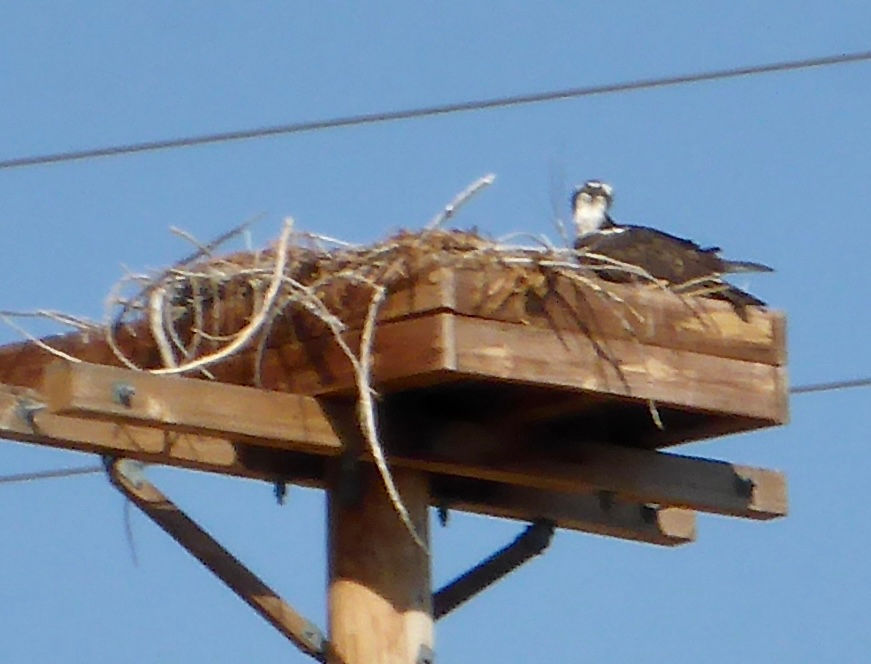
Flows: 54 cfs.
Moon Phase: New
Water Temp: 44F @ 2p.
Water clarity: Very clear to ~4’.
Air Temp: Low 34F @ 8a – high 57F @ 4p.
Hatches: Midge: Heavy throughout the day. BWO: No noticeable hatch.
Flies: #18 Soft Hackle Pheasant Tail, #22 Top Secret Midge, #22 Mercury Baetis, #22 Mercury Black Beauty, #16 Red Midge Larva, #20 Chocolate Thunder, #24 Olive Jujubee Midge, 18 Parachute BWO, #22 & 16 Sparkle Dun, #20 Canyon Cripple, #22 Matt’s Midge, #18 Theo’s Foam Back Emerger, #18 Red Dale’s Pale Midge, #20 Parachute Adams.
Top producers: Mercury Black Beauty, Jujubee Midge, Red Midge Larva, Dale’s Pale Midge, Matt’s Midge, #16 Sparkle Dun, Chocolate Thunder, Theo’s Foam Back Emerger.
There was a pair of ospreys working as a team. This one heading out and would soon return with a small fish to feed his nestling.
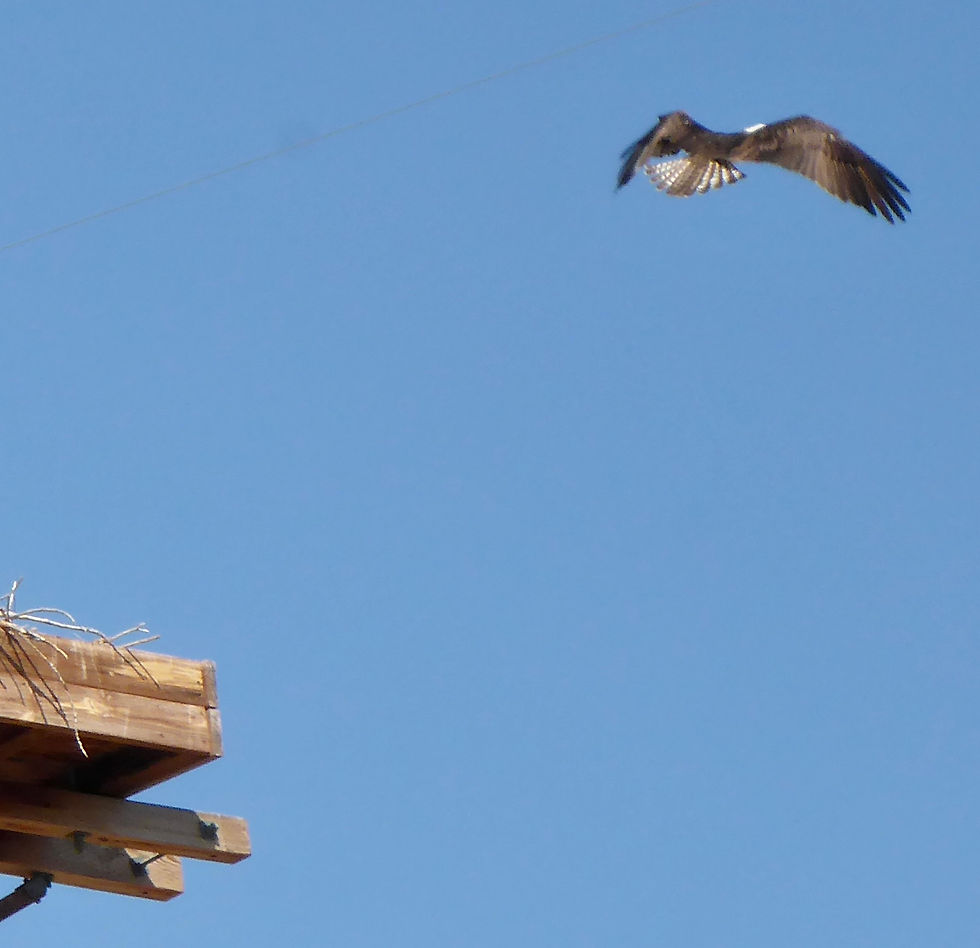
Another cold front moved into the mountains and the Denver area. That drove our decision to head south – to Pueblo and the Tailwater on the Arkansas River.
We were wavering though. The flows on the Tailwater were at a very low 54 cfs. The normal flow for this time of year is about 500 cfs. That had us worried. But the high in Deckers was forecasted to be only 41F. It always seems to be colder there than what they are calling for and both places were expected to have high winds. Pueblo’s forecast was for 61F.
We headed to Pueblo remembering last week when we fished the South Platte in Eleven Mile Canyon. The flows there were really low and we had a day to remember – fish everywhere. Maybe we’d have the same experience this week on the Tailwater.
Looking into the Osprey Run. (The osprey in the nest in the background.)
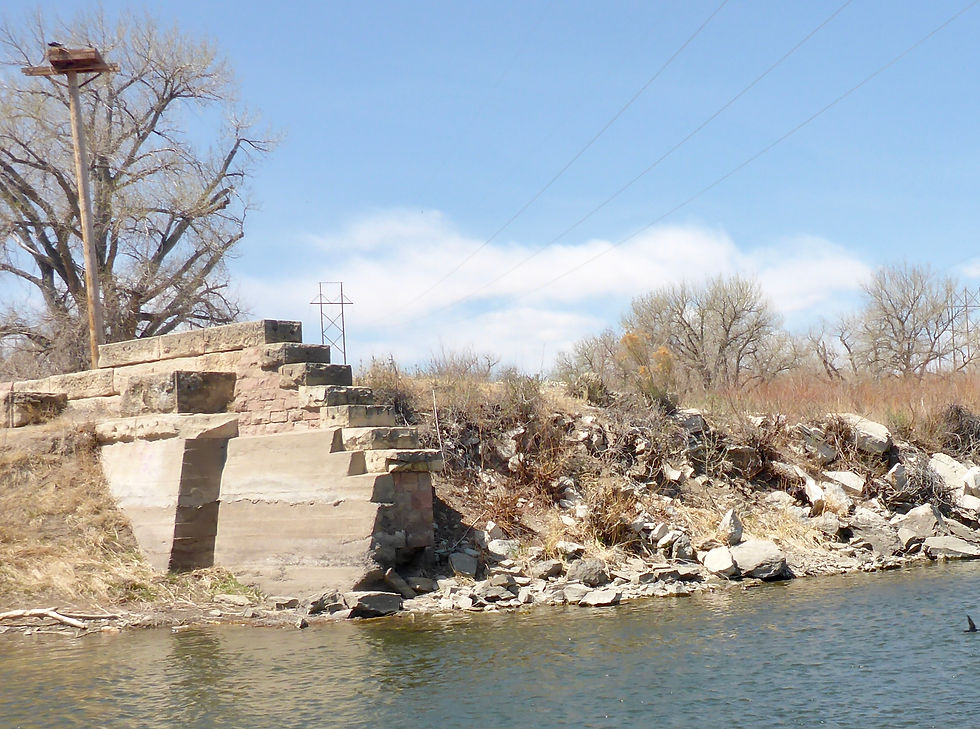
As we got close to Pueblo we chatted about where to start - thinking that any of the deeper holes would be good. Conventional wisdom says that the trout would go into the deeper water for protection – so that made sense. The Doubletree, the Diver Hole, the Tree Hole, The Hatchery Hole, the Tire Hole - all were viable options.
We picked the Hatchery Hole. If the trout were spread out, we’d have upriver to the Osprey Run and downriver to Tom’s Run to explore. Lots of water and hopefully lots of fish.
There’s a guy – Terry – who fishes the Hatchery Hole every morning from about 6a to 9a. He smokes a cigar and when it’s gone – so is he. When we fish it, Brian usually starts out fishing it with Terry and I wait until he’s gone – and if they were catching fish, I usually join Brian.
Big, beautiful rainbows and cutbows was the order of the day. Attested to by this 21" beauty.
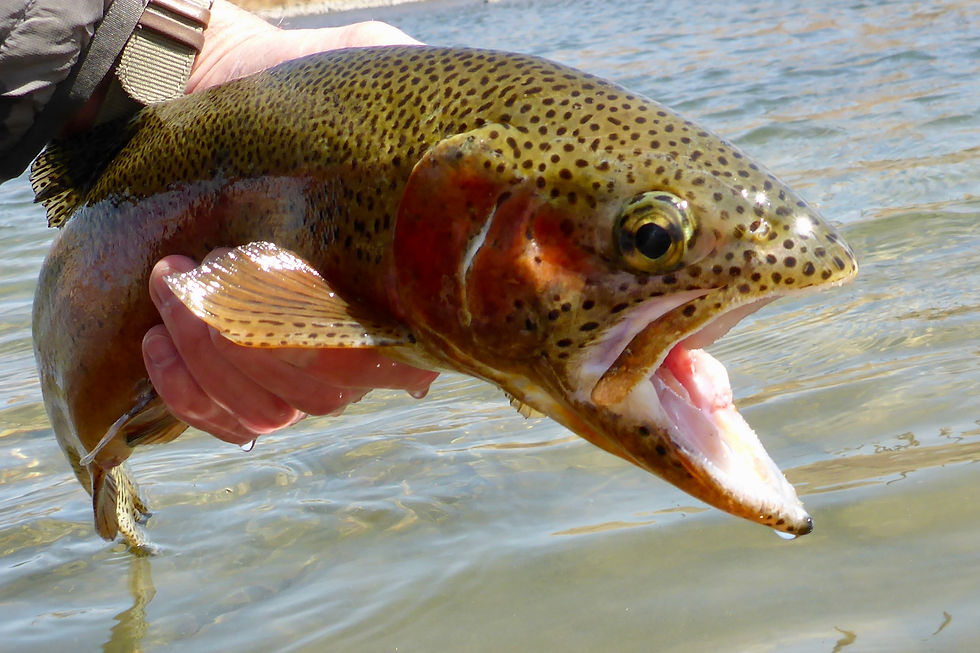
The same held true for this morning but when I came up to the hole Terry was already gone. Brian had the hole to himself and when I asked, Brian said Terry got a couple of nice ones. Sounded good to me, but for some reason I decided to check a small pocket upstream.
When I got there I could see a couple of trout in the pocket behind some boulders and darting out into the seams on either side of it. The water was very low and slow. I expected the fish to be very skittish and they were. Even the sight of my indicator moved them off their feeding spot. But they didn’t bolt and they would come back to the same place after a short bit.
I had a bubble on for my indicator and in retrospect I should have changed it out for a yarn indicator. They look more like some sort of debris in the water and are less likely to spook fish. Instead, my tactic was to hold my rod upstream after my cast so that my flies would float out in front of the indicator. That seemed to work as far as not spooking them, but they wouldn’t take my offerings.
Brian got this 21" skinny guy in the Hatchey Hole. (We think he was an older guy worn out by the spawn.)

Brian Kenney.
I don’t like to leave a spot where I can see trout – I keep telling myself that there has to be a way to get them to take. I’m stubborn that way. But after giving it a good half hour I decided to move on. My stuff was still on the bank of the Hatchery Hole and I walked down to get it. As I did, I was trying to decide to either go upstream – to the Osprey Hole – or downstream to the Valco Ponds Run.
First I’d check with Brian to see if he was catching them or not. I was thinking that if there were some trout in the pocket water – then maybe they’d be spread out in similar water. Brian didn’t have any hook ups when I came back and I was still undecided on where to go.
Just upstream from the Hatchery Hole is the Cliffs Run. It’s made up of riffles with troughs that lead into a weir and then there is a deep, slow pool below it. Upstream from that is the Osprey Run where I had a blast the last time we were here. The Valco Ponds Run is one of my favorite places to fish on the Tailwater – which led to my indecision. I finally made up my mind and decided to head upstream.
Got this 18" battler - a cutbow - in the troughs of the Osprey Run.

I tried the Cliffs Run and Brian soon joined me. Me in the riffles and troughs, and Brian down below in the slow deep pool. Neither of us had any action but Brian pointed out where he saw some fish rising in the pool. As I scanned it, I saw one come up. With my dry fly rig nearby on the bank I decided to give it a try - all the while thinking about the Osprey Run.
Finally, with no takers I pulled up stakes and headed up to the Osprey Run. As I approached I noticed that there was a pair of Ospreys nesting. They were up on the man-made platform. One took flight and soon returned with a small fish in his talons. Nature in action. It’s nice to witness and to think soon there will be more ospreys patrolling the river.
As I came up to the run there was another guy in it. He was fishing the lower half of the run from the opposite side. Standing on the hill above the water I could make out about five nice fish. They were in the pool on the upper side of the run so asked if he minded me fishing my side above him. The guy was very accommodating and welcomed me to join him. He had landed a couple of smaller rainbows and had one big one hooked up, but he broke off. They were hitting small files – but he didn’t know what they were.
My 1st catch of the day was this silvery, 14" rainbow. Brian got a handful of ones like this in the Hatchery Hole.
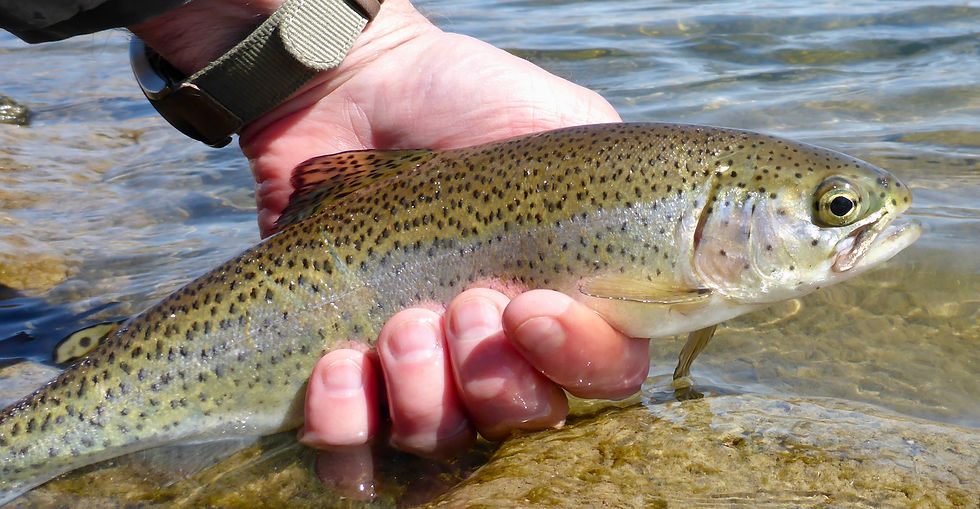
My nymph rig was set up with the way I left it last week. A #18 Soft Hackle Pheasant Tail leading, followed by a #22 Mercury Baetis and a #22 Top Secret Midge. There wasn’t a noticeable hatch taking place but I had noticed a bunch of birds – I think they were Swallows – swooping in groups above the river. A sure sign that a heavy hatch is underway. I think that the wind blew the midges around so much I couldn’t see them – but I knew they were there.
I left my rig as it was thinking that the Top Secret should do the trick. I had a .12g split shot on for weight and began to cast into the pool which was now a deep trough. I was casting directly into the wind and it wasn’t pretty. I can’t remember the last time I had so many casts smack the water. And I was having trouble with my targets – more than once with my indicator hitting the water on top of a fish that I was after – spooking him away.
I wasn’t getting any action and the first change I made was to my flies. I picked a #16 Red Midge Larva as my lead fly. I tied this fly this week – not really intending to use it right away, but I wanted a red midge and decided to give it a try. It’s a cross between a Disco Midge and a Blood Midge with a Mercury bead head and tied with red flash and black wire. I followed it with a #22 Mercury Black Beauty and a #22 Olive Jujubee Midge.
An 18" cutbow. (Notice the small "cut" on her lower jaw and the unique coloration.)
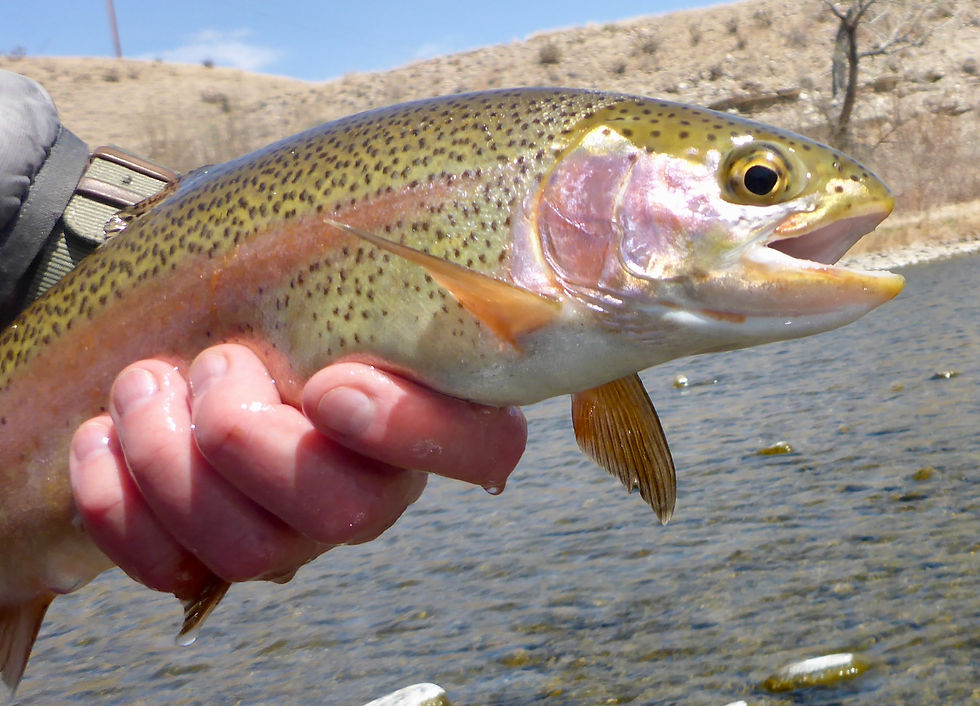
After a bit I noticed a lot of fish were on the upstream side of the pool in very shallow water. The pool was now only about two feet deep and the riffles feeding into it were less than a foot deep. I also noticed that the trout in the pool were feeding just below the surface – occasionally breaking it to get an emerging adult. The riffles were farther out than the pool and even more difficult to reach with the wind blowing in my face. And my drifts weren’t working. I kept getting caught up on the bottom of the very shallow water – again spooking the fish off.
It was then that I decided to take off all weight. My flies weren’t weighted either making for a very light rig. That’s what it took. Next cast into the pool and bang – a rainbow on. A fighter. Not the biggest rainbow – I was thinking 16” to 17” but he fought hard and didn’t want to come in. I was a bit hamstrung on the bank with not a lot of room to maneuver. He eventually broke off – but I was encouraged. I had my flies in the zone.
Next I went back into the riffles and soon had a smaller – 14” rainbow – in the net. By this time Brian had come up and joined me. The other guy was now further down the run so there was enough room for all of us. A bit later, Brian decided to head down to the Valco Ponds Run. I told him I’d soon follow, but then quickly had another rainbow in the net.
The troughs on the far side of the Osprey Run.

That made me decide to hang around a bit. And then the other guy pulled up and left me with the whole run. I was back in the pool targeting about four fish at the end of it. Three of them were in a line, side-by-side and the other one was behind them. Initially I was targeting the three in front – then I noticed that the last one was the biggest one.
The three in the front didn’t seem interested so I went after the big guy in the back. On my second or third attempt my indicator just paused. That was enough for me to set hard downstream. After my set it felt like I got snagged up on something – then the big guy made a move. What the heck was this?
I’ve snagged fish before that just sit there until they finally realize there is something stuck in them – then they run. Did I snag this guy?
Uniquely colored cutbow. Light olive body with raspberry cheek and stripe, and orangish colored fins.

No I didn’t. I had my rod held high – line tight – and after he moved he started to fight. His mouth open and his head shaking. I could feel his weight in my arms. There is a small pool of slack water on my side of the river at the end of the run and that’s where I directed him. I didn’t want to have to fight him and the current. To my amazement, this big rainbow didn’t put up much of a fight. I had him in the net in no time – a 21” brute. He took the Jujubee Midge.
On my next cast after releasing him – fish on! Wow – another nice 17” rainbow. Got him on my Mercury Black Beauty. It would be the fly of the day for me as I caught the majority of them on it. Needless to say the action was picking up.
It was about lunch time and besides the ones I had in the net, I had lost a handful too. I was trying to decide if I should head down to meet Brian – then eat my lunch – or stay here. I called him. That’s one advantage of fishing the Tailwater – it has cell coverage.
This big guy took the small Olive Jujubee Midge.

Brian said he had just walked up on the run. He’d made a pit stop back at the Hatchery Hole where he caught a bunch of smaller – 12” rainbows - on dries and a slim 19 incher on a #18 Red Dale’s Pale Midge. What fun! I was wondering what took him so long.
When he got to the Valco Ponds Run there were four other guys fishing it. So I suggested that Brian come back up and join me. The whole run was open. In fact I couldn’t see another fishermen on the water – upstream or downstream of me. And the fish were hitting!
Wouldn’t you know it. By the time Brian came back the fishing was a little off. There was still some action but not like it was just before I broke for lunch. There were some rising in the slower water at the end of the run and I eventually tried for them with my dry fly rig. I had a couple of refusals and a couple of hits – with both fish breaking off after taking my Parachute BWO.
The slower water at the bottom of the Osprey Run.
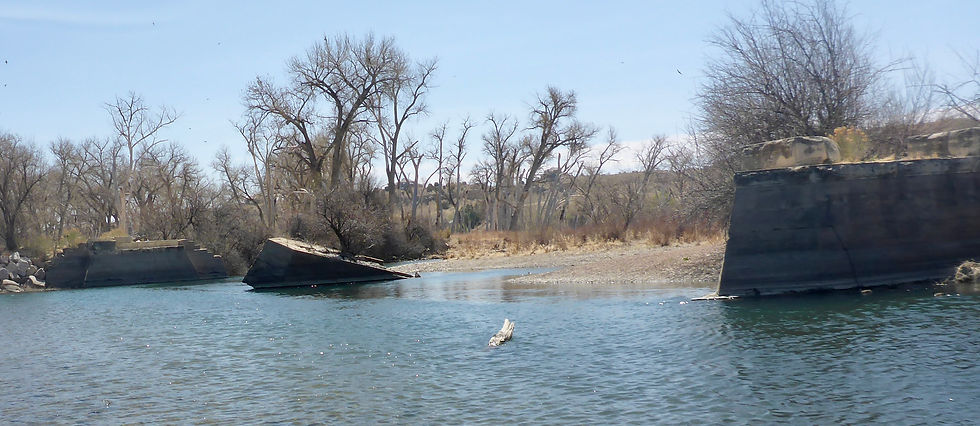
Brian had a couple of hook ups but they all broke off except for a 16” sucker who took a #18 Theo’s Foam Wing Emerger. Suckers are good for the river. You’ll find them on the bottom using their big lips like a vacuum cleaning up the place! And eating various aquatic insects – like the baetis that the Theo’s imitates.
Earlier in the day I had wondered to the other side of the river to check a little pocket of water where I’ve seen some fish the last time here. They were there – but I spooked them off. I noticed that they ran into some riffles – faster water to the side of the small pool. I waded to the other side of the riffles to try for them – but didn’t get any takers. I took note to come back later.
Well it was now later and I waded over to the pocket – being as stealthy as possible. Even though – I still managed to spook them and they ran into the faster riffles again. But this time one of them stayed in the near side seam. He didn’t go far and it looked like he was happy to sit there and feed on whatever was floating by.
Brian got this Sucker feeding on the bottom of the Osprey Run.

Brian Kenney.
I went after him.
At one point I spooked him again – but again, he didn’t go to far. Just farther into the riffles which was fine by me. The last place he was sitting was difficult to get a good drift. My indicator would float into the slower water near the pool – messing up my drift. Now he was in a place I could get a decent drift.
Casting into the fast water, I noticed that my flies were swaying way out and on top of the water. Not what I wanted - so I added my .12g split shot back on for weight and adjusted my indicator - lowering it - for the shallow water. That was enough to fool him.
BANG!
He hit one of my flies and very quickly bolted to the other side of the riffles near the far bank. I knew he was a big fish - but was surprised how big he was! Another beast of a rainbow – his brightly colored head out of the water shaking to free himself. Which he did. Oh man – that was too nice of a fish to lose!
Releasing a cutbow.
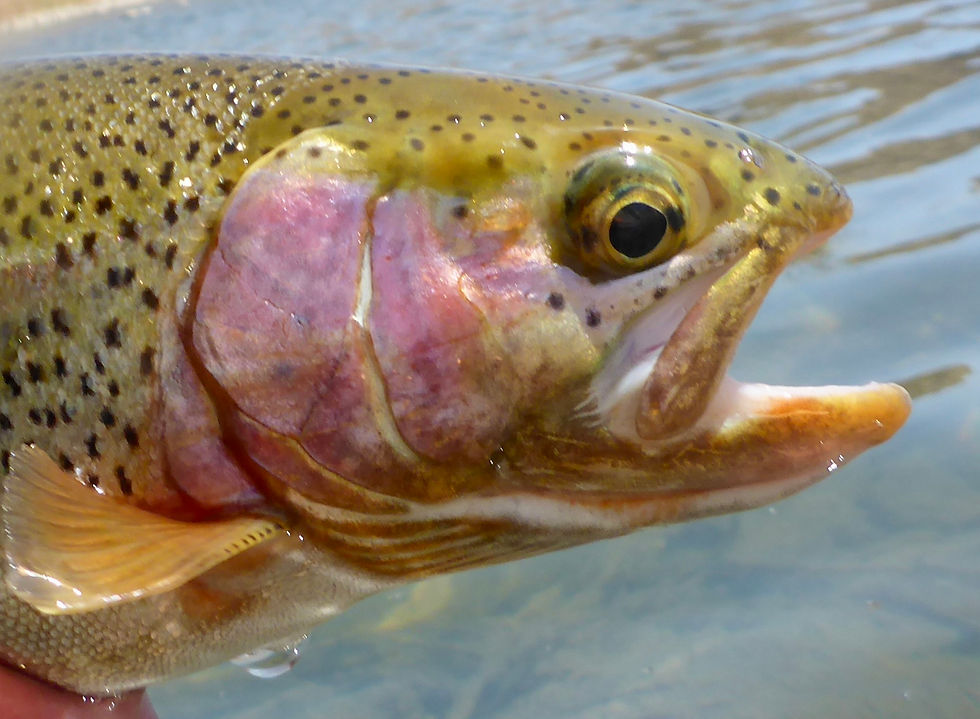
As I was fighting him, I noticed some more fish in a trough of slower water below the riffles and some more in the middle of the riffles.
Game on!
I would get a handful of fish out of the riffles and the trough below them. Another 21 incher, a few 20”, a 19”, and a 18” battler that Brian netted for me. The 18 incher took the Red Midge Larva and the others took the Mercury Black Beauty. They were all a ton of fun to land.
I had noticed the 21” rainbow (it would end up being a cutbow) in the trough. It wasn’t a deep trough and I could see his dorsal fin as he fed on the midges that were in and on the water. It was a no doubter when he hit. Indicator abruptly stopping. Hard downstream set. Rod bowed. Line tight. A heavy, head shaking, brightly colored cutbow taking me all over the place. I finally netted him above the pool on the other side of the river – where I started fishing the run earlier.
He and the other cutbows had a distinct coloration. They looked like they were a different strain - as pretty of a fish as one that I’ve ever seen.
Brian got a good picture of this 21" bull cutbow.
(I found a handful of ones like this in the troughs.)

It was now getting late in the afternoon and I was losing steam.
We had to work hard for these fish – fighting the elements, the wind mostly – and we had to crack the code to get our flies in the zone and offer them what they wanted.
Another stellar day on the river and we were both dead tired as we walked to the car.
Comentarios